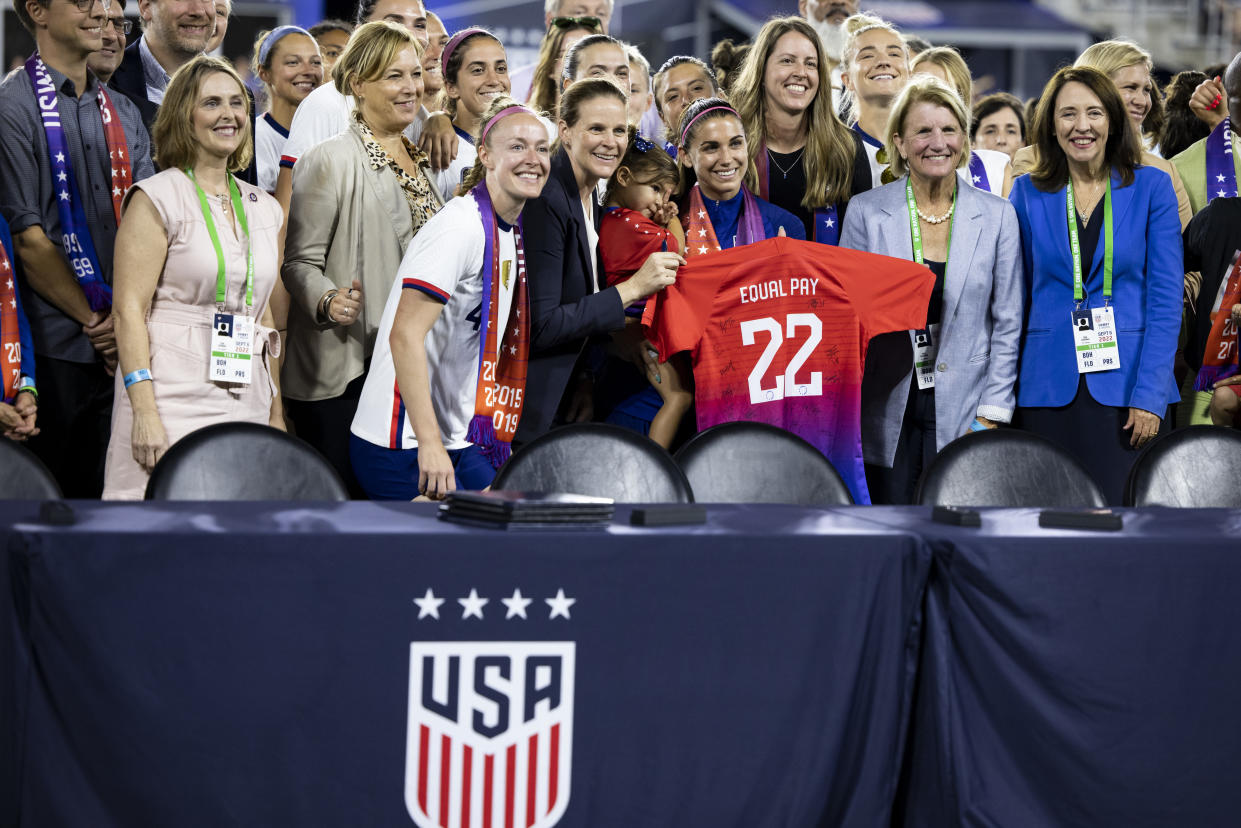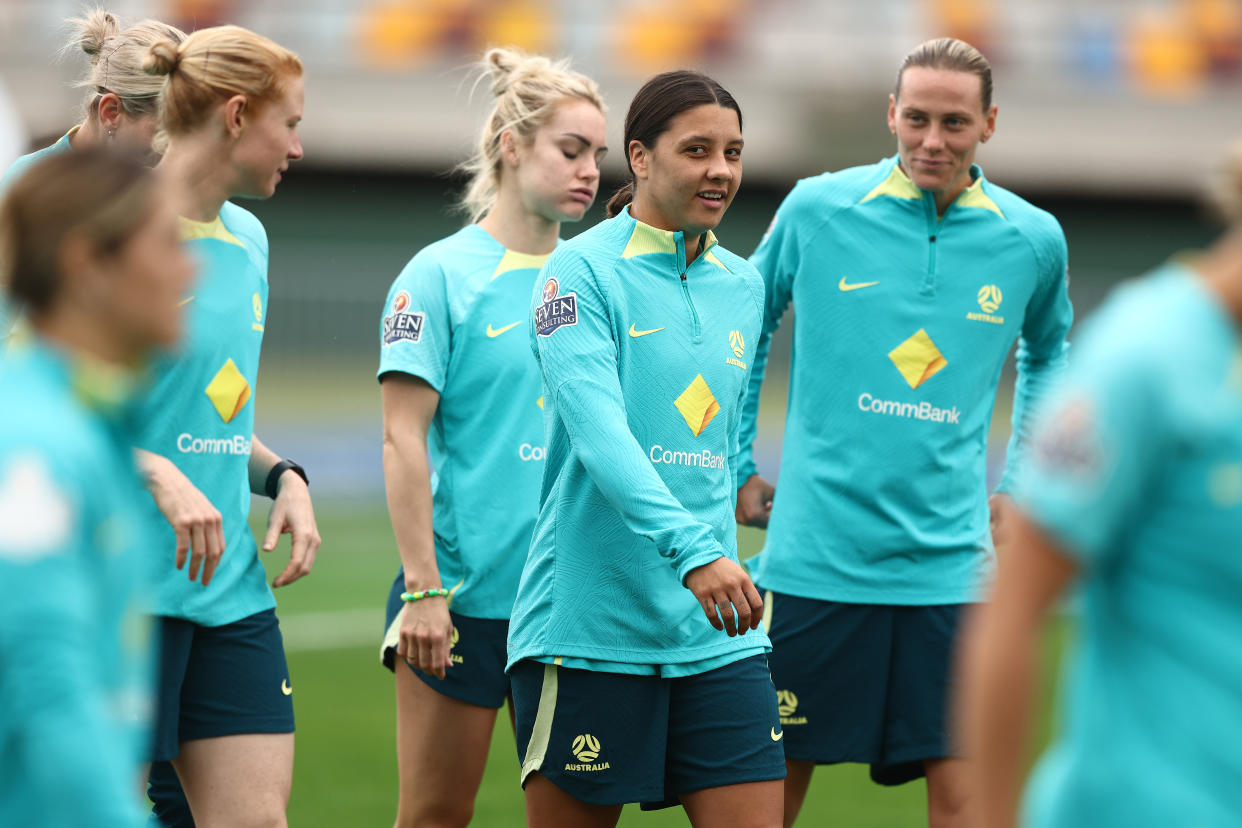The USWNT won equal pay. The women's soccer world is still fighting
AUCKLAND, New Zealand — Prideful smiles beamed off the pitch on the night victory was declared. The U.S. women’s national team had spent decades bitterly fighting for it. They’d gone to court and Congress and countless bargaining sessions in a bid for equal pay. They won it, finally, last May, then gathered months later in Washington D.C. to celebrate — and to send a message.
They could have easily signed their landmark collective bargaining agreement in a backroom flanked by lawyers. Instead, on a field with thousands watching, Crystal Dunn pounded a table in excitement; Megan Rapinoe hugged predecessors who’d paved the way; shrill cheers serenaded the entire USWNT as player reps officially signed the CBA, a deal that now pays them on par with the U.S. men in every conceivable way.
They did it there, flanked by powerful politicians and cameras, in part because they wanted to set a visible example.
“Honestly,” midfielder Rose Lavelle said late that night, “I hope that this is a domino effect for every other [national soccer] federation, to see that this is something that's tangible and necessary and needed and deserved.”
Ten months later, though, they are still hoping.
They are here in Auckland, preparing for their first equally compensated World Cup, enjoying cryotherapy chambers and red light therapy and other “modalities” that “really make us feel professional,” midfielder Kristie Mewis said.
But they are also waiting for the rest of the world to follow their lead.
“Our team is in a way different space than we were going into the 2019 World Cup,” forward Alex Morgan acknowledged. “But it's not just us that were fighting.”
There are 32 teams at the 2023 Women’s World Cup, and 31 are Down Under on lesser terms than their male counterparts. Some, such as Canada, are fighting for equal working conditions and pay. Others, such as Spain, have been weakened by federations that refuse to listen to their players. There have been almost a dozen public battles big and small that have plagued the buildup to the grandest women’s sporting event in modern history. And there are hundreds of unseen inequities that persist behind the scenes.

There has, of course, been progress. “A lot of progress, and I think that needs to be talked about and celebrated,” U.S. winger Megan Rapinoe told Yahoo Sports last month. FIFA, the World Cup’s organizer, equalized many aspects of the player experience, from base camps to travel. It also threw an additional $80 million into the women's prize money pot and guaranteed that at least $30,000 will go to each of the tournament’s 736 players.
“FIFA has actually done — surprisingly, coming out of my mouth — a very good job at increasing the prize money,” Morgan said.
But there’s “still a ways to go,” she added; and “there's still so much to fight for,” Rapinoe said.
The $110 million prize money chest is still only a quarter of the men’s pot. FIFA’s investment in the Women’s World Cup — $155 million in 2019, $435 million budgeted in 2023 — still pales in comparison to its spend on the men’s World Cup — $1.8 billion in 2022, $3.8 billion budgeted in 2026.
And its promotion of the two tournaments is still visibly disparate. Qatar’s entire capital, Doha, was covered in World Cup branding and signage seven months ago, whereas Auckland, the site of Thursday’s opener, mostly feels like a bustling city going about its everyday business.
FIFA, though, has made strides and teased even bigger ones, including equal prize money in 2027. As a result, the steady drumbeat of battle has largely targeted individual soccer federations — whose direct mistreatment of players is, Rapinoe said, “infuriating.”
Equal pay struggles a global trend for women's national teams
The World Cup year began with belief, with bubbling optimism in more than a dozen countries, including Canada — until the Canadian Soccer Association detonated it. The women’s national team entered 2023 as reigning Olympic gold medalists; they expected to be treated as such. Instead, the CSA slashed the team’s funding. Budget cuts left the players with a smaller staff, fewer training sessions and an underserved youth development system, all of which "compromised" their World Cup preparations, they said in February.
They threatened to strike at the time. A procedural hurdle kept them at work. But they were “deflated,” “exhausted” and “shattered,” they said. They flew to Australia last month with a temporary, short-term contract imminent, but they aren’t thrilled about that, either.
“It’s pretty disgusting that we’re having to ask just to be treated equally,” midfielder Janine Beckie said in February. “It’s a fight that women all over the world have to partake in every single day, but quite frankly, we’re really sick of it.”
And so are their foreign peers. In England, players pressed for better pay but said Tuesday that after months of pressing, they were “disappointed that a resolution has still not been achieved.”
In South Africa, players boycotted a pre-World Cup friendly over “welfare” and contracts.
In Jamaica, players once again expressed their “utmost disappointment” with their federation last month. They’d aired “concerns” related to “subpar planning, transportation, accommodations, training conditions, compensation, communication, nutrition and accessibility to proper resources.” They’d been left to wonder, two or three days before the start of some training camps, whether the camp would even happen. They’d been told that issues would be resolved, but “time has expired,” they said. They went public — and one player’s mom launched a GoFundMe to crowdsource financial support.
— Cheyna Matthews (@Cheynalee_) June 15, 2023
In Nigeria, according to American coach Randy Waldrum, the federation canceled a pre-World Cup training camp. It also allegedly retaliated against one player following a pay dispute and pressured Waldrum to exclude that player from his World Cup roster. When he refused, the federation stripped his staff of its top assistant coach, Lauren Gregg. Gregg called it “blatant discrimination” and “retaliation.”
And it’s why so many players across the globe don’t or can’t speak up about what they see.
In Colombia, it has sparked fear ever since several players were cut shortly after speaking up about wage theft, sexual harassment and more. “Because of that fear,” former player Natalia Ariza recently said, “they [no longer] speak out about many things that need to change and be spoken about.”
In Spain, 15 players privately raised concerns about the national team environment under head coach Jorge Vilda. Instead of working to assuage those concerns, the federation waged a public relations war on the players. Vilda left some off the World Cup roster; others, including Barcelona stars Mapi Leon and Patri Guijarro, have chosen not to play.
In France, federation officials eventually caved to players’ wishes and ousted head coach Corinne Diacre after three stars resigned from the national team in protest.
But in many instances, the World Cup is too grand an event to risk.
“It’s a huge platform,” U.S. defender Kelley O’Hara said of this tournament. But, she noted, when players have a cause, “you have to figure out, is this something that you want elevated [and] talked about right now? Because some teams don’t. Like, they’re not looking to do that in this moment.”
USWNT's triumph fuels worldwide demands for equal pay
The U.S. women rode the power of this moment to unparalleled heights in 2019 and beyond. They won a second straight title and inspired an inexorable wave of public sentiment. That reverberated from Lyon to New York, framing the World Cup final as a rallying cry: “Equal pay! Equal pay!”
The players secured it, plus millions of dollars in settlement money, in 2022. And once they did, their phones started ringing.
“Federations are even reaching out,” USWNT Players Association president Becky Sauerbrunn said in September. “They want to know what the CBA looks like, how it works.”
U.S. Soccer president Cindy Parlow Cone said both players and executives contacted her and colleagues to ask: “How did [you] do it? Can you help us do it?”
They weren’t the first international soccer team to claim equal pay, but they were the first to truly achieve it. Other CBAs had guaranteed men’s and women’s players equal percentages of their respective World Cup prize money winnings. But the prize money pots were grossly unequal. U.S. Soccer and its players devised a scheme to fix that.
The women and men agreed to pool their World Cup prize money and each take 45%, with the remaining 10% going to U.S. Soccer (40-40-20 in 2026 and 2027). They also jointly bargained with the federation, their part-time employer, for appearance fees, win bonuses and commercial revenue shares. They became two of the highest-paid national teams in the world, irrespective of gender.
But the women also knew they were the privileged exception on their side of the sport.

FIFPRO, the global soccer players’ union, recently surveyed 362 international players and found that 93% “believe there should be an improvement in pay and prize money”; 29% didn’t receive any compensation at all. Many women’s teams don’t have any agreement with their federations for portions of World Cup prize money — which has traditionally been paid directly to those federations and distributed to players only if they collectively bargained for it.
Many of those players are still amateurs or neglected semi-pros. Their love for the beautiful game has been suppressed by insufficient support systems unable to fund it. Two-thirds of those players surveyed by FIFPRO said they’d had to “take unpaid leave or vacation time from another form of employment to participate in” regional championships. Only 40% of them considered themselves professionals.
And that, FIFPRO realized, is what the World Cup could single-handedly change. “We want players to professionalize through this tournament in regions and countries where club football doesn't allow for that,” FIFPRO general secretary Jonas Baer-Hoffmann said via Zoom this spring.
His vision was “good funding that gives the players social security leading into a tournament.” The $30,000 guarantee, for each of the 23 players on every team that fails to advance past the group stage, will help do that. For every player in the Round of 16, $60,000 will do even more.
“And then obviously, as the prize money pool increases, it would extend the period [of security] longer and longer,” Baer-Hoffmann continued. “And ultimately, hopefully, it’s enough that players can basically go around a [four-year World Cup] cycle based on this funding, being certain that they have enough to live off of and be professional.”
That would likely depend on a full equalization of prize money pots, which FIFA has not quite promised. Australian players, in a video released a few days before their home-soil World Cup opener, called out the still-wide gap — $440 million for the men in 2022, $110 million for the women this year.
At FIFA’s annual congress in March, though, president Gianni Infantino adopted a striking new stance on the matter. Backed by FIFA’s resolve to commercialize women’s soccer, he invited broadcasters and sponsors to fuel the sport’s rising tide. And if they do step up?
“Our ambition would be, of course, to be able to have equality in payments for the 2026 men's and ‘27 women's World Cups,” Infantino said. “This is the objective that we set.”
